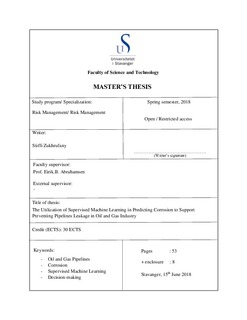| dc.description.abstract | Pipelines have become indispensable in oil and gas industry to support transportation of flammable and poisonous fluids such as crude oil, natural gas, and refined petroleum products. They carry fluids in larger volume, safer way, and more environmental friendly compared to trucks and rails. However, like any other equipment, pipelines can have various failures to some degree. One of which is studied in this thesis work that focused on leakage. Leakage in the pipelines can initiate the occurrence of progressive accidents, such as fluid spillage, fire, and explosion. The exposure of that accidents can lead to the injuries, even worst, fatalities, environmental and asset damages, bad reputations, financial distress, and more other negative impacts. Thus, it is important to implement risk-reducing measures that can prevent pipelines leakages. Preferably, the measures must be capable to handle the root causes of the leakages.
Many incidents analysis has shown that leaking phenomena in the pipelines mainly caused by corrosion. Hence, corrosion assessment is crucial to be conducted for decision making in choosing safety measures to avoid leaking incidents. Considering, the type of corrosion, its severity, and factors that can initiate corrosion. Expectedly, preventing actions can be determined and applied based on the root-causes factors.
However, corrosion assessment in the pipelines is a difficult task to execute. This is because of the uncertainty of the future occurrence of corrosion in pipeline. Furthermore, the changing of environmental conditions nowadays, make prediction of the corrosion more difficult. The location of the pipelines for oil and gas operations, which are normally built in a great distance and located in surface and sub-surface also adding complexity in detecting corrosion accurately. Consequently, there are numerous factors that can trigger corrosion to be considered. Therefore, in order to deal with such circumstances, corrosion must be analyzed under multifarious factors per pipelines sections. The tool that can be utilized to estimate such prediction is supervised machine learning. This technology is recognized providing accurate and rapid prediction outputs based on big, various, and complex data.
The purposes of this thesis are to analyze the appropriateness of supervised machine learning in forecasting corrosion and its outputs to support the decision-making in preventing pipelines leakage. The methodologies used in the study are by reviewing literature, and studying the supervised machine learning technology, including how it processes and delivers outputs.
A suggested framework is given to improve limitations of supervised machine learning tool for better decision-making. The framework is constructed by integrating two methods. Initiated by performing a hidden uncertainty analysis method, to better reflect the aspects of uncertainty that can be neglected by the tool. Undertaking this method can minimize surprising outcomes. The second approach adopted is qualitative risk matrices, where the predicted outputs from the tool and consequences analysis outputs are compared. The results of such comparison can assist risk assessors in identifying the level of risk and suggesting recommendations and safety measures to prevent leakage in the pipelines effectively. | nb_NO |

